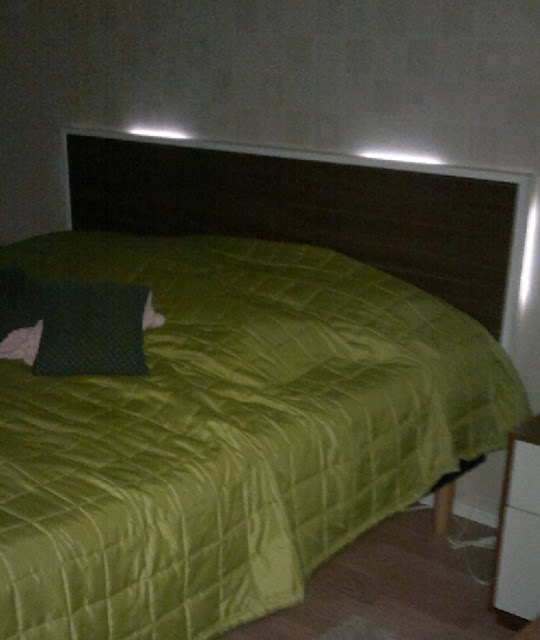Materials: Pragel kitchen worktop, Dioder led lights, corner molding, door frame plugs, drill, nailgun (or hammer), screws
Description: We wanted to have a modern and cheap headboard, which wasn't easy to find. So we ended up hacking an IKEA kitchen worktop, which was the exactly right size for our bed. Our bed is 180 cm wide and the Pragel worktop is 186 cm. We also decided to modernize it with some IKEA's Dioder led lights. We also used some corner mouldings to surround the worktop, which also hid the edges of the worktop. We used 6-inch screws to fasten the worktop to the wall and hid the screw heads with door frame plugs.
Putting the headboard together was surprisingly easy.
1. Measure and cut corner moldings to right measure to surround the top and the sides of the worktop (in our case the bottom was hidden by the bed).
2. In our case, we had to buy untreated mouldings, so at this point they were painted white (several layers to get the mint look).
3. If you want to add the led lights, you have to leave some space between the wall and the headboard. For this, we screwed a couple of wooden flat mouldings to the back of the worktop, to get the right gap taking into account that the corner mouldings were a bit wider than the countertop's thickness (we wanted to leave a gap of 12 mm so that the gap between the mouldings and the wall was about 5 mm so that the light shows).
4. After this, we fastened the Dioder lights in the back of the worktop.
5. The next step was to drill suitable holes. We drilled 13mm wide, 1,5 cm deep hole and rest of the hole as 5 mm wide. This was because we used 5*150 mm screws to fasten the headboard. The bigger portion of the hole was for the door frame plugs that covered the screw heads. We drilled the holes at places where the mouldings from point 3 were (6 holes in total; three scattered evenly on top and three at the bottom).
6. Now we lifted the headboard to the wall. The worktop is quite heavy so we used a couple of stands that were exactly the right height we wanted. At this point it was important to ensure that the Dioder wires were safely at the back. Then we drilled the 6-inch fastening screws in place and inserted the door frame plugs.
7. After this, it was time to fasten the corner mouldings to the sides. We used a nailgun, but it can be done with a hammer and nails or with screws as well.
Now all that was left was to put the light on the LEDs!
~ Superpallo, Finland

























Post A Comment:
0 comments:
Post a Comment